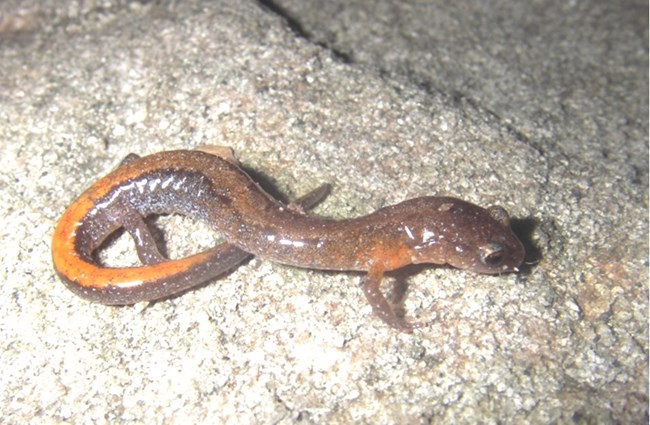
NPS Photo Family: Plethodontidae Plethodon serratus Southern Red-backed Salamander
Size: 6.4 to 12.5 cm long (2 ½" to 4 ¾") General Description: Two color phases exist: "red-backed" and "lead-backed." "Lead-backed" is gray to black and has no distinct stripe but may have red specks on sides. "Red-backed" phase has red or orange stripe along back bordered by gray to black sides. Red pigment may also mix with dark stripe on side but not onto belly. Margin of stripe may have saw-toothed, serrated, or wavy edges, but sometimes straight-edged. Serrations of stripe tend to correspond to costal grooves and folds. Intermediates of color phases may be found. Black and white to yellowish mottled belly. 18 to 21 costal grooves. Sexually active males have crescent shaped mental gland on chin. Nasolabial groove present although sometimes hard to see. Tail rounded. Similar Species: May be best distinguished from Eastern Red-back Salamanders, Plethodon cinereus, by difference in range. However, the range of these species may overlap or be inaccurate depending on the source. Lead-backed phases may occur in all similar species. Dusky Salamanders, Desmognathus sp., are differentiated by a light line from the eye to the angle of their jaw and their hind legs are larger than their front legs, as compared to this species which does not have the line and its limbs are all about the same size. Mole Salamanders, Ambystoma talpoideum, do not have a nasolabial groove and typically have a much chunkier body shape. Reproduction: Presumed to breed October to April. Habitat: Commonly found under rocks, logs or leaf litter in moist woodlands or mesic hardwood forests, but may be well way from open water source. May live at elevations up to 1690 m (5,544'). Behavior: Little information is known about their life history. Females are presumed to lay their eggs in underground burrows. Adults are often found to be more active during fall, winter and spring, than during the summer. Documentation of defensive mechanisms or behaviors is unavailable.
|
Last updated: October 15, 2021
